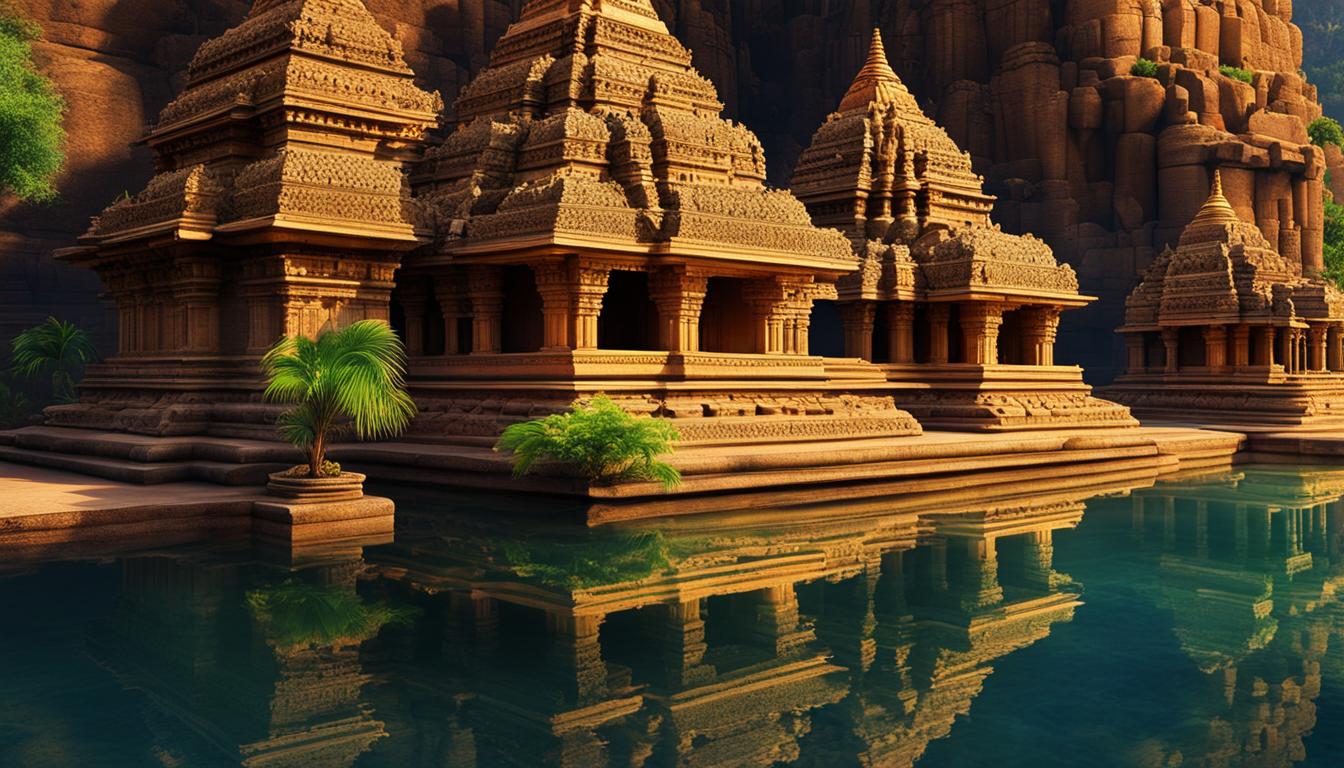The Pallavas, an ancient Indian dynasty that reigned from the 3rd to the 9th century CE, left a lasting legacy of architectural marvels, cultural contributions, and historical impact. Originating as a minor clan, the Pallavas rose to power in Tamil Nadu, showcasing their architectural brilliance and artistic prowess through the construction of magnificent temples and monuments. Their cultural influence extended beyond the borders of India, as they established a strong maritime presence and engaged in trade with Southeast Asia and China.
Today, the Pallava Dynasty is revered for its remarkable contributions to South Indian architecture, culture, and history. Their temples and monuments, renowned for their intricate carvings and exquisite designs, stand as testaments to their architectural achievements. Alongside their architectural prowess, the Pallavas were patrons of art, literature, and classical dance forms, further enriching the cultural heritage of the region.
Key Takeaways:
- The Pallava Dynasty thrived as an ancient Indian dynasty from the 3rd to the 9th century CE.
- Pallavas excelled in architectural marvels, leaving behind stunning temples and monuments.
- They had a strong maritime presence and engaged in trade with Southeast Asia and China.
- Their cultural contributions included art, literature, and classical dance forms.
- The Pallava Dynasty’s heritage is celebrated for its architectural brilliance and cultural impact.
Architectural Achievements of the Pallavas
The Pallavas were renowned for their extraordinary contributions to architecture. Mahabalipuram, also known as Mamallapuram, stands as a testament to their brilliance in Pallava architecture. This coastal town in Tamil Nadu is home to a plethora of iconic Pallava temples and monuments, each showcasing exquisite craftsmanship and intricate designs that continue to awe visitors to this day.
One of the most remarkable examples of Pallava architecture is the Shore Temple, an ancient structural stone temple built in the 8th century CE. It stands proudly as one of the oldest stone temples in South India, highlighting the Pallavas’ mastery of Dravidian architecture.
The Pancha Rathas, a group of monolithic rock-cut temples, further exemplify the Pallavas’ engineering prowess and artistic finesse. These awe-inspiring structures, modeled after chariots from Hindu mythology, showcase the Pallavas’ ability to carve intricate details directly from solid rock.
Arjuna’s Penance, a colossal bas-relief sculpture, narrates scenes from the epic Indian tale, the Mahabharata. This incredible piece of art, hewn into the face of a massive granite rock, serves as a testament to the Pallavas’ skill in rock-cut artistry and their deep appreciation for storytelling through visual mediums.
The Pallavas’ architectural brilliance extends beyond these renowned landmarks. Temples like the Kailasanatha Temple and the Vaikuntha Perumal Temple further exemplify their talent and artistic legacy.
Through their architectural achievements, the Pallavas have left an everlasting impact on the world of art and culture. Their mastery of Pallava architecture, characterized by intricate carvings, magnificent structures, and rich symbolism, continues to fascinate and inspire visitors from around the globe.
Mahabalipuram: A Hub of History, Culture, and Natural Beauty
Mahabalipuram, located on the stunning Coromandel Coast of Tamil Nadu, is a true gem waiting to be explored. This charming town is renowned for its rich history, vibrant culture, and breathtaking natural beauty. One of its main attractions is the awe-inspiring Shore Temple, a UNESCO World Heritage Site that stands as a testament to the architectural brilliance of the Pallava dynasty.
In addition to its magnificent temples and monuments, Mahabalipuram boasts a series of pristine beaches that are perfect for unwinding and indulging in water sports. Mahabalipuram Beach, Serenity Beach, and Covelong Beach are just a few of the coastal treasures that await visitors. These sandy stretches offer not only relaxation but also an opportunity to immerse oneself in the beauty of the Coromandel Coast.
Mahabalipuram is also home to several other noteworthy temples, including the Varaha Cave Temple and the Mahishasuramardini Cave Temple. These architectural wonders provide a glimpse into the rich religious and cultural heritage of the region. Moreover, the town hosts the revered Mahabalipuram Dance Festival, a celebration of Indian classical dance forms that captivates audiences from around the world.
With its intriguing historical sites, picturesque beaches, and vibrant cultural scene, Mahabalipuram is a must-visit destination for history enthusiasts, art lovers, and nature enthusiasts alike. Immerse yourself in the mesmerizing stories of the past, bask in the sun-kissed sands, and witness the grace and beauty of Indian classical dance at the renowned Mahabalipuram. There is something truly special about this town that will leave a lasting impression on every visitor.
FAQ
What is the Pallava Dynasty?
The Pallava Dynasty was a significant dynasty in South India from the 3rd to the 9th century CE. They were an ancient Indian dynasty that originated as a minor clan but rose to power in Tamil Nadu.
What were the Pallavas known for?
The Pallavas were known for their impressive architectural achievements. They built remarkable temples and monuments renowned for their exquisite carvings and intricate designs. They also had a strong maritime presence and expanded their influence through trade with Southeast Asia and China. They were patrons of art, literature, and classical dance forms.
What are some notable architectural marvels built by the Pallavas?
Some notable architectural marvels built by the Pallavas include the Shore Temple in Mahabalipuram, which is one of the oldest structural stone temples in South India. The Pancha Rathas, a group of monolithic rock-cut temples, and Arjuna’s Penance, a massive bas-relief sculpture, are also remarkable examples of Pallava architecture and artistry.
Where is Mahabalipuram located?
Mahabalipuram is located on the Coromandel Coast of Tamil Nadu, India.
What makes Mahabalipuram a must-visit destination?
Mahabalipuram is a treasure trove of history, culture, and natural beauty. It is famous for its ancient rock-cut temples and monuments, including the UNESCO World Heritage Site, the Shore Temple. Mahabalipuram also offers pristine beaches, such as Mahabalipuram Beach, Serenity Beach, and Covelong Beach. Visitors can explore other notable temples like the Varaha Cave Temple and the Mahishasuramardini Cave Temple. The town is renowned for its cultural festivals, including the Mahabalipuram Dance Festival, which showcases Indian classical dance forms.
